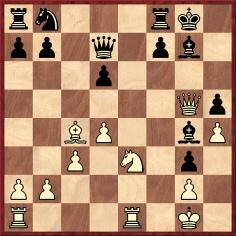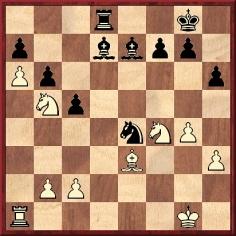Chess
Notes
|
| First column | << previous | Archives [69] | next >> | Current column |
6514. Bishop underpromotion
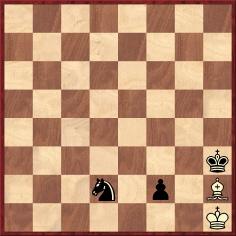
This position (White to move) was given on pages 262-263 of Combination in Chess by G. Négyesy and J. Hegyi (Budapest, 1965). It is described as ‘a possible subvariation’ from the game Haág v L. Szabó, Budapest, 1958, and the moves indicated are 1 Bg1 f1(B), and Black wins.
See also page 193 of Chess Curiosities by T. Krabbé (London, 1985):

In databases the score of the Haág v Szabó game can be found as far ‘63 Ke3 Nxf6 0-1’:
1 e4 e5 2 Nf3 Nc6 3 d4 exd4 4 Nxd4 Bc5 5 Nb3 Bb4+ 6 c3 Be7 7 c4 Nf6 8 Nc3 Bb4 9 Bd3 a5 10 O-O a4 11 e5 Nxe5 12 Nd4 O-O 13 Bg5 Bxc3 14 bxc3 h6 15 Bh4 Ng6 16 Bg3 d6 17 Re1 Re8 18 Rxe8+ Nxe8 19 Rb1 Nf6 20 Bc2 a3 21 c5 dxc5 22 Nb5 Qxd1+ 23 Rxd1 Bd7 24 Nxc7 Rc8 25 c4 Nf8 26 Be5 Be6 27 Nxe6 Nxe6 28 Bf5 Ra8 29 Bc2 Rd8 30 Rxd8+ Nxd8 31 Bf4 Nc6 32 Bc1 Na5 33 Bxa3 b6 34 Bd3 Ne8 35 Bc1 Nd6 36 Kf1 Kf8 37 Ke2 Naxc4 38 Bxc4 Nxc4 39 Kd3 Nd6 40 a4 Ke7 41 Ba3 Kd7 42 f3 Kc6 43 g4 Kd5 44 Bb2 g6 45 Bg7 h5 46 h3 Nc4 47 Bf6 Ne5+ 48 Ke3 Nd7 49 Bd8 c4 50 a5 bxa5 51 Bxa5 Nc5 52 gxh5 gxh5 53 Bc3 Ne6 54 Bf6 Kc5 55 f4 Kd5 56 f5 Nc5 57 Ba1 Ne4 58 f6 c3 59 Kd3 Ke5 60 Ke3 Kf5 61 Kd3 Kf4 62 h4 Kf5 63 Ke3 Nxf6

Is anything more known about the game’s conclusion?
6515. Nimzowitsch’s invention
John Blackstone (Las Vegas, NV, USA) provides this cutting from page 11 of the Brooklyn Daily Eagle, 7 September 1911:

6516. Early recognition of Smyslov
Page 144 of A Chess Omnibus quoted from page 32 of the February 1943 BCM, and below for the record is the magazine’s complete item:

This photograph of Smyslov comes from page 151 of the May 1943 Chess Review:

6517. C.G. Hallock
The Chess Prodigies article has a reference to C.G. Hallock, and we shall shortly be adding this citation:
‘Master C.G. Hallock, a boy of 13, has won the first prize in the tournament of the Minnesota Chess Club. The St Paul Pioneer Press says of him: “His style for one so young is singularly steady and correct, his judgment is excellent, and he possesses qualities which, in time, will rank him among the greatest players.”’
Source: International Chess Magazine, August 1887, page 239.
6518. Reinfeld and Rubinstein
From page 27 of How to Play Chess Like a Champion by Fred Reinfeld (New York, 1956):
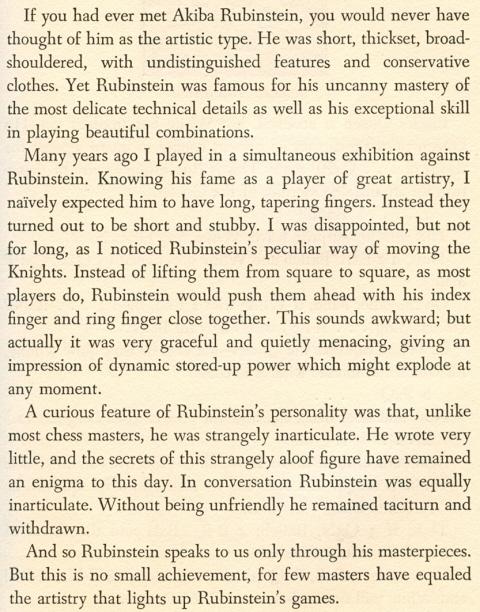
Reinfeld’s game against Rubinstein was played at the Marshall Chess Club in New York on 18 February 1928. Rubinstein’s opponents included E. Tholfsen (one of two winners) and M. Hanauer (one of two players who drew), and among the 20 losers were Reinfeld, H.R. Bigelow, W. Frere, B.M. Anderson, J.C.H. Macbeth and A.E. Santasiere. Source: New York Times, 20 February 1928, sports section, page 17.
Rubinstein’s loss to Tholfsen was given on page 261 of Akiba Rubinstein: The Later Years by J. Donaldson and N. Minev (Seattle, 1995).
Below is a picture of Rubinstein from opposite page 628 of the May 1927 issue of L’Echiquier:
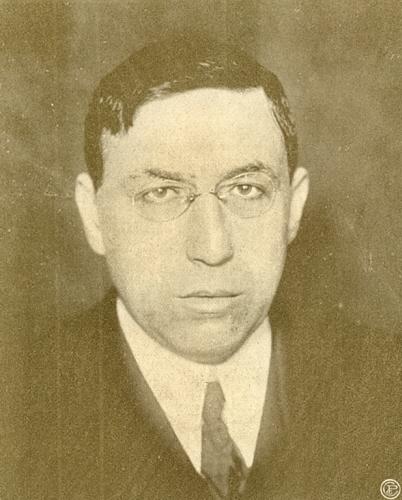
6519. Consulting books (C.N. 6441)
Henk Smout (Leiden, the Netherlands) quotes from the Wiener Schachzeitung, April 1905 (pages 119-120) a text which had appeared in the New-Yorker Staatszeitung of 19 March 1905:
‘Die St. Petersburger Schachgesellschaft hatte sich schon vor mehreren Monaten an Herrn Prof. Rice mit der Bitte gewandt, mehrere Preise für ein Ricegambit-Turnier zu stiften, und der Erfinder des Gambits entsprach dem Ansuchen bereitwilligst, jedoch unter der Bedingung, daß das Turnier erst nach Erscheinen der neuen Auflage des Rice-Gambit-Buches beginnen dürfe.
... In derselben Lage, wie die Russen, befanden sich aber auch die beiden Amerikaner Marshall und Napier. Diese Herren sitzen schon seit einigen Tagen kampfbereit in London.’
Our correspondent comments:
‘This sheds light on the “permission” to consult documentation granted to players in Rice Gambit theme tournaments, which seems to be less a favour to them than a precondition by Professor Rice to guarantee in-built progress by ensuring that fully-informed strong players would not re-invent the wheel.
Another telling point is the cablegram which he sent the players during the Monte Carlo theme tournament of 1904 in order to contradict analysis by Johann Berger in the Deutsche Schachzeitung. The cablegram is mentioned in the Wiener Schachzeitung, June 1904, page 171, in the comments to the game Marco v Fleischmann, and the analytical contents were printed at the end of the game, on pages 172-173.
Rice had evidently forgiven Marshall the two earlier losses which could have been avoided through optimal knowledge available at the time. In addition to the case mentioned in C.N. 6441, with colours reversed Marshall (White) lost again to Swiderski in the sixth round of Monte Carlo, 1904 (Wiener Schachzeitung, June 1904, pages 183-184) ...
... with 12 Nd2 Ne3 13 Qh5 Bg7 14 d6 cxd6 15 Nf1 Bg4 16 Qb5+ Qd7 17 Bxe3 fxe3 18 Qg5 O-O 19 Nxe3 h5 20 Nd5 Kh8 21 Rf1 f6 22 Nxf6 Qd8. The same position, there considered lost for White by Alapin, had already been reached, with White’s 18th and 19th moves transposed, on page 89 of the February-March 1904 issue of the Wiener Schachzeitung, where Alapin wrote of Black’s 16th move that any move should win with more or less ease. That is the same article that his opponent had to hand over to him because of Marshall’s protest during the first round. The whole incident would not have happened, of course, had Swiderski kept the article to himself and studied it in his hotel room before the first round began.
On page 12 of the fifth edition of The Rice Gambit (1910) by Emanuel Lasker 20 Rf1 Kh8 21 Rf6 is indicated as giving “a strong game” (for White).
Marshall and Swiderski had prepared together for the eighth round, as mentioned on page 188 of the June 1904 Wiener Schachzeitung in the note to Black’s 14th move in the game Marco v Swiderski (which was mistakenly called Swiderski v Marco). It began 1 e4 e5 2 f4 exf4 3 Nf3 g5 4 h4 g4 5 Ne5 Nf6 6 Bc4 d5 7 exd5 Bd6 8 O-O Bxe5 9 Re1 Qe7 10 c3 Nh5 11 d4 O-O 12 Rxe5 Qxh4 13 Rxh5 Qxh5 14 Bxf4 Nd7.’
6520. Ödön Gesztesi
Edgar Guest (Billericay, England) writes:
‘I am researching the life of my Hungarian grandfather Ödön (Edmond) Gesztesi (1873-1919). Pages 256-258 of Chess Comet Charousek by V.A. Charuchin (Unterhaching, 1997) report that he participated in the First Hungarian Individual Correspondence Chess Championship, 1893-1897, and his loss to Charousek is given.
Gesztesi was the editor of the magazines Budapesti Sakk-szemle and Magyar Sakkujság. In 1904 he was living in Nagyvárad (now Oradea in Romania). He was born there on 11 February 1873. On 8 June 1899 he was appointed Deputy Treasurer of the Nagyvárad Municipality, and in 1900 he joined the Nagyváradi Napló newspaper as a staff reporter. On 28 April 1903 he married Laura Varga. The local newspaper Nagyvárad reported on 20 March 1904 that Gesztesi was the clear winner of a nationwide correspondence chess tournament. By 1912 he had divorced my grandmother. Leaving her and their young son, my father Imre, behind, he moved to Paris, where he earned a living as a translator. He translated into Hungarian some of the “Fantômas” crime stories by Pierre Souvestre and Marcel Allain. During the Great War he was interned in Paris as an enemy alien. He contracted tuberculosis and died at Lesvellec, Saint-Avé, Morbihan, France on 18 March 1919.’
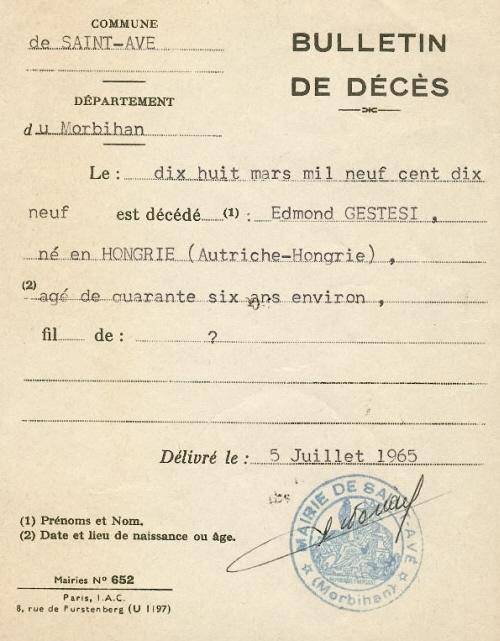
We begin by recalling that a version of the smothered mate brought off by Gesztesi (Gestesi) was given on page 48 of Kings, Commoners and Knaves, having been published on page 177 of the May 1911 issue of La Stratégie:
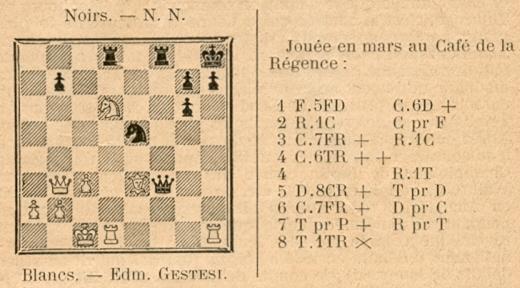
Page 179 of the same issue provided details of simultaneous displays given by him:
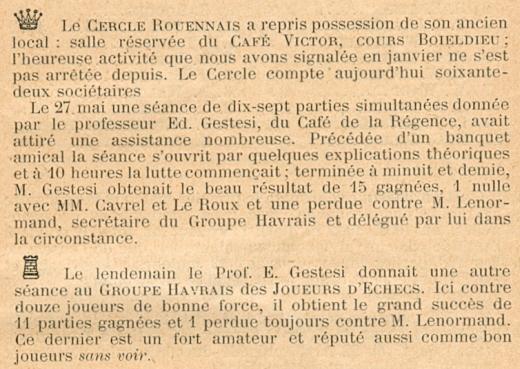
As regards the earlier part of his life, the first three volumes of Magyar Sakktörténet (Budapest, 1975-1989) contain a number of references. Volume one (page 171) gave this position (Black to move) from Silbermann v Gesztesi, Nagyvárad, 1893:
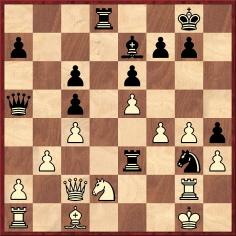
18…Ne4 19 Nxe4 Qe1+ 20 Kh2 Rxh3+ 21 Kxh3 Qh1+ 22 Rh2
Qf3+ 23 Ng3 Qxg3 mate. This conclusion was published
on page 180 of the June 1893 Deutsche
Schachzeitung.
From page 232 of volume two comes this game:
Géza Maróczy – Ödön GesztesiBudapest, 1 June 1905
King’s Gambit Accepted
1 e4 e5 2 f4 exf4 3 Bc4 Nf6 4 Nc3 Bb4 5 Nf3 O-O 6 O-O Bxc3 7 dxc3 Nxe4 8 Bxf4 d6 9 Qd4 Nc5 10 Bg5 Qd7 11 Ne5 dxe5 12 Qxc5 Qg4
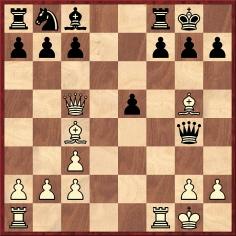
13 Qxf8+ Kxf8 14 Rxf7+ Ke8 15 Re7+ Kf8 16 Rf1+ Bf5 17
Rf7+ Ke8 18 R1xf5 Nd7 19 Re7+ Kd8 20 Rxg7+ Kc8 21 Rg8+
Nf8 22 Be6+ and mate next move.
Then there is the mysterious case of Gesztesi v
Abonyi (1 e4 c5 2 Nf3 Nc6 3 Nc3 e6 4 d4 cxd4 5 Nxd4
Nf6 6 Ndb5 Bb4 7 Nd6+ Ke7 8 Nxc8+ Rxc8 9 Bd2 Bxc3 10
Bxc3 Nxe4 11 Bxg7 Rg8 12 Qg4 Rxg7 13 Qxg7 Qa5+ 14 c3
Nb4 15 Rc1 Qc5 16 Qh6 Qxf2+ 17 Kd1 Rc6 18 White
resigns). Volume three of Magyar Sakktörténet
(page 182) states that the game was played in Budapest
in 1915, whereas there are books and databases which
date it 1940. See, for example, page 241 of 1000 Best
Short Games of Chess by I. Chernev (New
York, 1955). However, the game was published on pages
55-56 of the March-April 1915 issue of the Wiener
Schachzeitung, although without any specific
statement that it had been played that year. The score
was given too on page 245 of the August 1915 Deutsche
Schachzeitung, with the heading ‘Vor einiger
Zeit im Budapester Schachklub gespielt’.
Page 140 of the June 1912 American Chess Bulletin referred to a new fortnightly magazine, La Renaissance Echiquéenne, mentioning, with respect to the double number 5-6, that ‘the joint editors are Edmond Gestesi and Raymond Latouche’. The appearance of La Renaissance Echiquéenne (which is not in our collection) had been noted on page 109 of the March 1912 issue of La Stratégie, with a reference to R. Latouche only, and the production standards were praised:
‘Le premier fascicule, que nous avons en mains, se présente très coquettement: papier de luxe, très bonne impression, supplément photographique, etc., bref tout à fait luxueux.’
Page 369 of the September 1912 La Stratégie reported that La Renaissance Echiquéenne had ceased publication after its 13th issue (1-15 July).
6521. En el ocaso
From Christian Sánchez (Rosario, Argentina):
‘I can provide an even better quality version of the Capablanca picture than those in C.N. 4918. It comes from page 342 of Andrés Clemente Vázquez’s En el ocaso (Havana, 1898), a compilation of his periodical articles.’
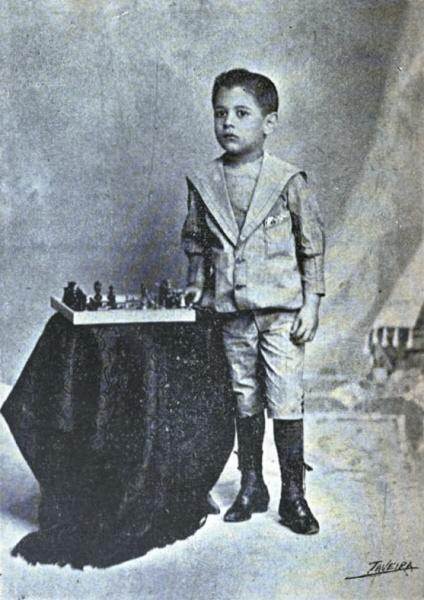
6522. A.L. Viesca
Further to our material on Andrés Ludovico Viesca (see pages 52-53 of Chess Explorations), Mr Sánchez notes that page 331 of En el ocaso reprinted the article about the prodigy from the 24 October 1876 issue of La Estrategia Mexicana and that the item gave another game by Viesca (then aged seven), besides his win against José Martí.
Andrés Ludovico Viesca – Agustín MendiolaVenue? September or October 1876
King’s Pawn Opening
1 e4 e5 2 Nf3 Bc5 3 Nxe5 Qf6 4 d4 Bb6 5 Be3 Nc6 6 Nxc6 bxc6 7 e5 Qg6 8 Nc3 Ba5 9 Bd2 Ne7 10 Ne2 Bxd2+ 11 Qxd2 Nf5 12 f3 Qe6 13 Nf4 Qe7 14 Qd3 Qb4+ 15 c3 Qxb2 16 Rb1 Qxa2 17 Qxf5 g6 18 Qe4 g5 19 Ne2 d5 20 exd6+ Be6 21 dxc7 Rc8 22 Qxc6+ Kf8 23 Qc5+ Ke8
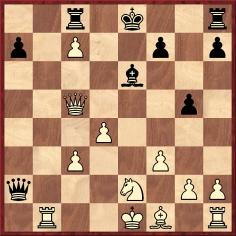
24 Nc1 Qxb1 25 Bb5+ Bd7 26 Qe5+ Kf8 27 Qxh8+ Ke7 28 Qe5+ Be6 29 O-O f6 30 Qc5+ Kf7 31 d5 Bf5 32 g4 Bg6 33 Ba6 Resigns.
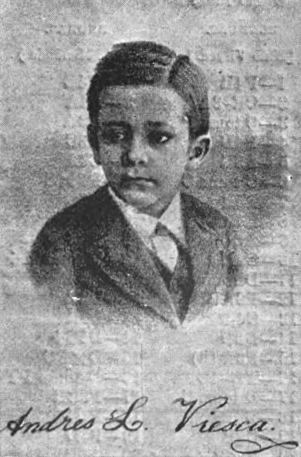
Andrés Ludovico Viesca
6523. Bishop underpromotion (C.N. 6514)
Michael McDowell (Westcliff-on-sea, England) points out that a miniature study by S.G.Belokon quoted on page 310 of Test Tube Chess by A.J. Roycroft (London, 1972) shows promotion to both knight and bishop and the same finish as in the Szabó position.
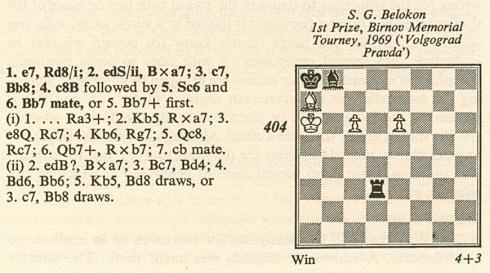
6524. Thomas Hood and Wyllie/Wylie (C.N. 5392)
Rod Edwards (Victoria, BC, Canada) writes:
‘In C.N. 5392 you gave excerpts from Hood in Scotland which describe Thomas Hood playing chess with a friend, Andrew Wyllie. Is this the “Wylie” who was part of the Edinburgh team in the London v Edinburgh correspondence match which started in 1824? The team members were named by Staunton on page 329 of the 1842 volume of the Chess Player’s Chronicle, and by H.J.R. Murray on page 879 of A History of Chess. It is reported on page 114 of Hood in Scotland that Andrew Wyllie died prematurely in the autumn of 1825, so if he did start out in the Edinburgh team he did not see it through to the end.’
Readers’ assistance with this query will be appreciated. Our only addition at present is that The Games of The Match at Chess (London, 1829) also had the spelling ‘Wylie’, and also gave no forename.
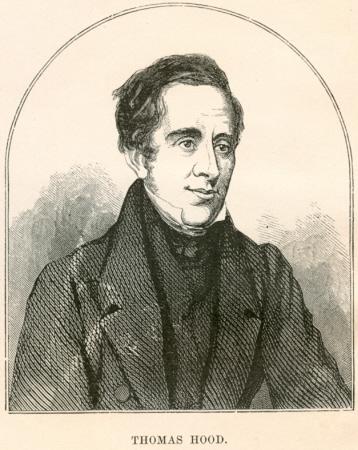
The illustration above is the frontispiece to The Prose Works of Thomas Hood, volume one (Philadelphia, undated).
6525. Alekhine at Prague, 1931 (C.N. 6507)
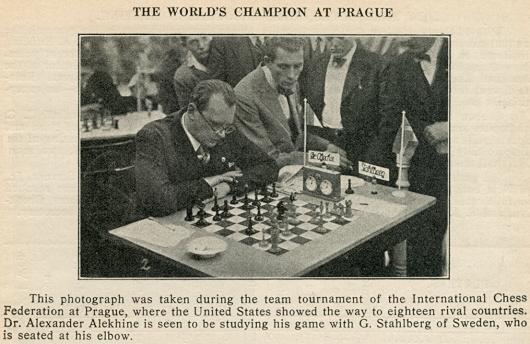
A question concerning this photograph, from page 153 of the September-October 1931 American Chess Bulletin, is whether the person seated at Alekhine’s elbow is indeed Ståhlberg. For purposes of comparison, below are two photographs of the Swedish master from the period in question:
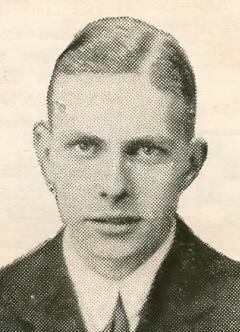
Source: Tidskrift
för Schack, January 1930, page 10.
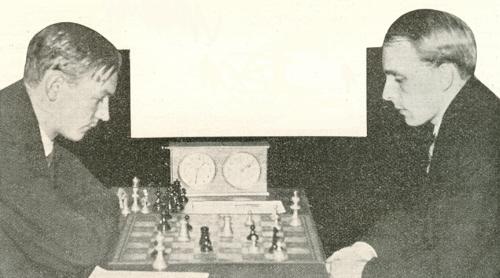
G. Stoltz v G.
Ståhlberg. Source: Tidskrift för Schack,
December 1931, page 205.
As regards the unpopulated version of the Alekhine photograph, Jan Kalendovský (Brno, Czech Republic) notes that it appeared on the front cover of Šachy by Karel Zmatlík (Prague, 1934):
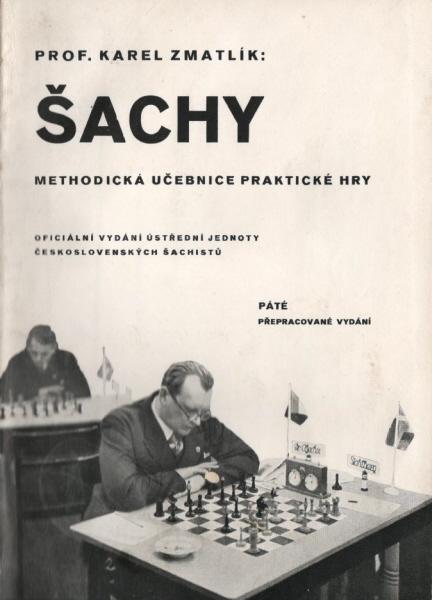
6526. Who?
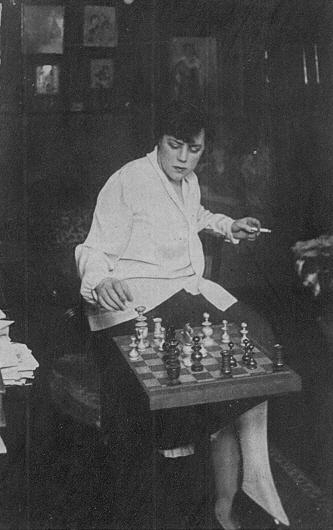
6527. Ajeeb
and Marshall
John Blackstone (Las Vegas, NV, USA) sends this report from page 26 of the Brooklyn Daily Eagle, 14 January 1935:
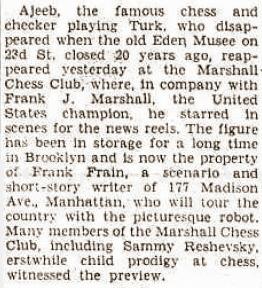
Can any reader discover whether the footage has survived?
Page 219 of Chess: Man vs Machine by Bradley Ewart (London, 1980) stated:
‘Under Frain’s guidance Ajeeb was reintroduced to the world in early January 1935. At that time the automaton, “rigged out anew in resplendent oriental regalia”, posed for a newsreel troupe at the Marshall Chess Club with US Champion Marshall himself. Frain later claimed that Marshall “encountered Ajeeb at chess, and went away shaking his head after a draw”.’
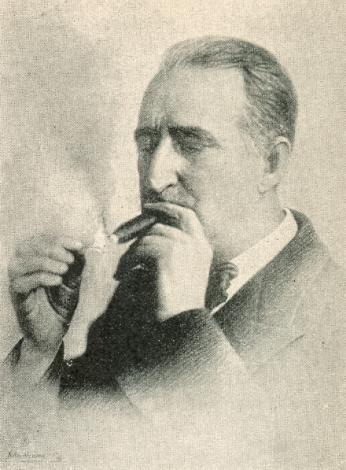
Frank James Marshall (American Chess Bulletin, December 1935, page 171)
6528. Morphy quote
A remark often ascribed to Paul Morphy is ‘Help your pieces so that they can help you’, but so far we have been unable to trace it back further than page 64 of Bréviaire des échecs by S. Tartakower (Paris, 1934):
‘“Aidez vos pièces pour qu’elles vous aident”, telle était la devise du génie d’échecs, Paul Morphy.’
The English version is on page 49 of A Breviary of Chess (London, 1937):
‘“Help your pieces so that they can help you” was the motto of that genius of chess, Paul Morphy.’
6529. Prague, 1931 Olympiad (C.N.s 6507 & 6525)
Knud Lysdal (Grindsted, Denmark) sends us the following photographs from his collection:
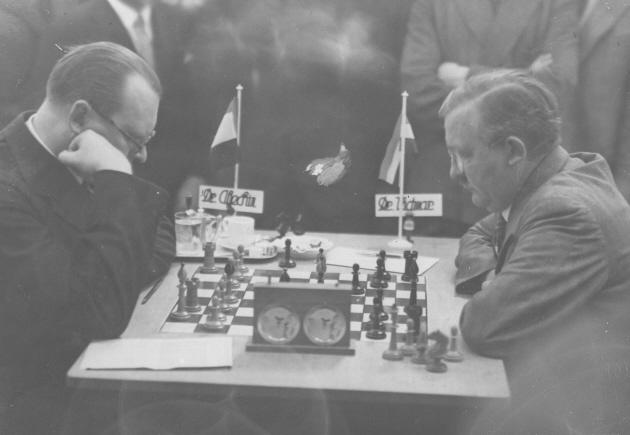
A. Alekhine v M. Vidmar

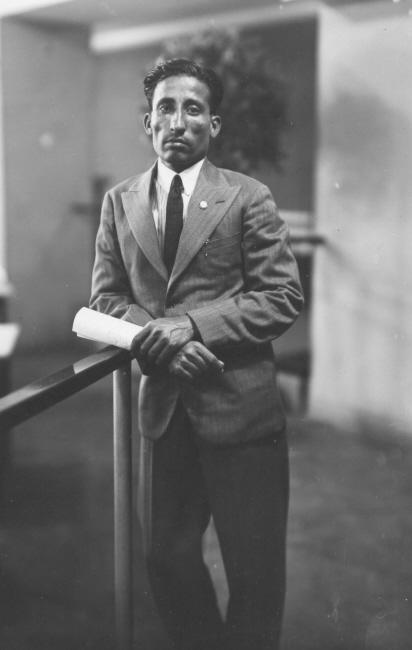
Sultan Khan
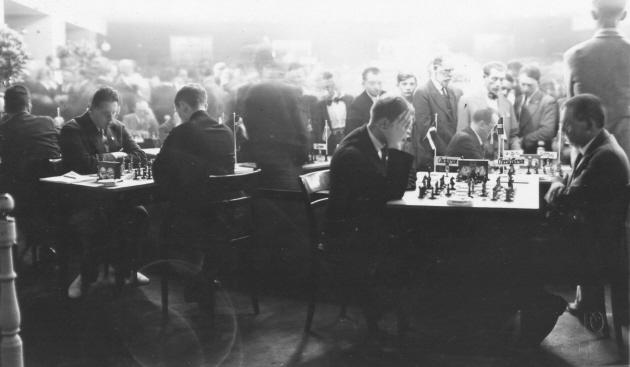
A larger version of the final photograph is provided, and we shall be reverting to the identity of some of the players. The bow-tied onlooker on the right (familiar from C.N.s 6507 and 6525) makes a welcome re-appearance.
6530. Capablanca cutting
Tony Gillam (Nottingham, England) forwards this cutting from page 12 of the New-York Tribune, 9 February 1913:
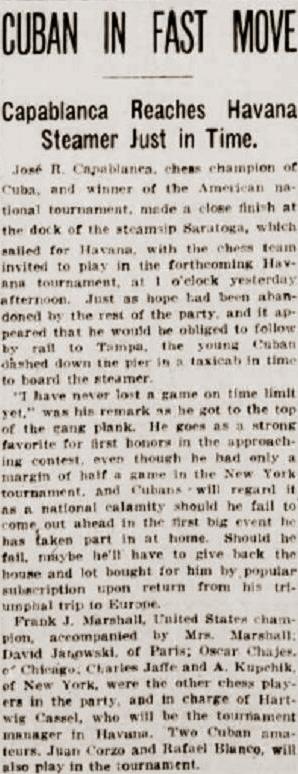
6531. Smyslov’s first published game
Javier Asturiano Molina (Murcia, Spain) raises the subject of the first published game by Smyslov.
Game one in Smyslov’s book 125 Selected Games (Oxford, 1983) was his win as Black against Gerasimov (‘Championship of the Moskvoretsky House of Pioneers, Moscow, 1935’), and his concluding remark (page 20) was:
‘This was my first tournament game to appear in print (in the newspaper 64)’
If a reader has that issue of 64 and can provide a copy of the Smyslov game, we shall gladly reproduce it here.
6532. Wilson and Labourdonnais (C.N.
6506)
From Rod Edwards (Victoria, BC, Canada):
‘In C.N. 6506 you posted my query about Harry Wilson giving Labourdonnais knight odds in 1815, and you provided some additional information. I have just found a further reference by George Walker, in Le Palamède, 1842, page 320. He claimed not only that Wilson played Labourdonnais at knight odds but also that Wilson won several times. The year was given as 1816.’
The text in question:
‘M. Wilson est un des premiers noms anglais pour les échecs, et l’on peut le dire ici, puisqu’à Paris, en 1816, il gagna plusieurs fois Labourdonnais, en lui donnant le Cavalier. Ainsi changent et passent les gloires de ce monde.’
6533. Morphy quote (C.N. 6528)
‘“Help your pieces so that they can help you” was the motto of that genius of chess, Paul Morphy.’
Hassan Roger Sadeghi (Lausanne, Switzerland) comments that this reference by Tartakower to Morphy’s ‘motto’ does not necessarily mean that the American himself made the explicit statement. Was it merely Tartakower’s way of summarizing Morphy’s style of play?
6534. Signatures (C.N. 6497)
C.N. 6497 showed a set of signatures in one of our copies of the Dover edition of Capablanca’s Best Chess Endings by Irving Chernev (New York, 1982):
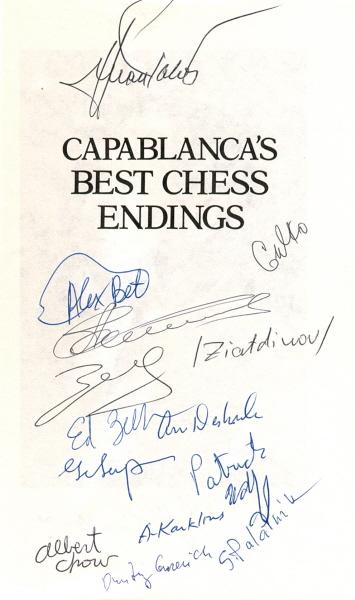
A good attempt at identifying the inscriptions was received from Richard Reich (Fitchburg, WI, USA), and here we add that a key was provided by Alex Betaneli on the opposite page of our copy:
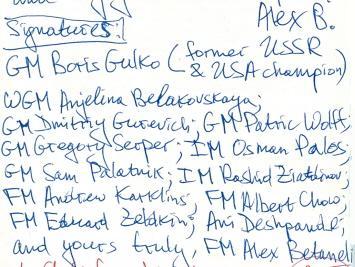
6535. Ten seconds per move
An item contributed by us on pages 26-27 of the Winter 1990 issue of Kingpin:
David Hooper and Dale Brandreth’s The Unknown Capablanca (London, 1975) published two of the Cuban’s rapid transit games (against Meyer and Rosenthal), ‘all that could be found although Capablanca was the fastest player in the world for more than twenty-five years’ (page 100).
Jack O’Keefe (Ann Arbor, MI, USA) has now discovered a third specimen, played in the finals of a ten-seconds-per-move tourney held just before the New York, 1924 international tournament. Since Capablanca finished first with 8-2, a point ahead of Schapiro and Tenner, the game had a decisive influence on the final standings.
Morris A. Schapiro – José Raúl CapablancaNew York, 11 March 1924
Queen’s Gambit Declined
1 d4 d5 2 Nf3 Nf6 3 c4 e6 4 Nc3 c6 5 e3 Nbd7 6 Bd3 b6 7 O-O Bb7 8 e4 dxe4 9 Nxe4 c5 10 Qe2 cxd4 11 Nxd4 Bc5 12 Nb3 O-O 13 Bg5 Be7 14 Rad1 Nxe4 15 Bxe7 Qxe7 16 Bxe4 Bxe4 17 Qxe4 Nf6 18 Qh4 Rac8 19 Rd4 a5 20 Rfd1 a4 21 Nd2 e5 22 Rd3 Qb4 23 b3 axb3 24 axb3 Rfd8 25 Ne4 Rxd3
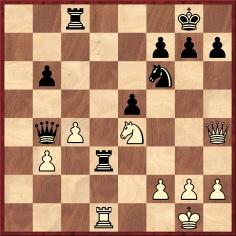
26 Nxf6+ gxf6 27 White resigns.
Source: Christian Science Monitor, 15 June 1924.
Jack O’Keefe comments:
‘If the score is correct, Schapiro resigned when he had a simple perpetual check by 27 Qg4+, and Capablanca could have won by 26...Kf8 (27 Nxh7+ Ke8). Not easy to see at ten seconds per move.’
A crosstable of the event was published on page 52 of the March 1924 American Chess Bulletin. The field included Maróczy and Tartakower.
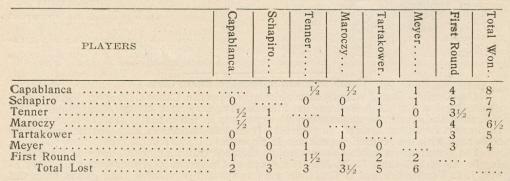
6536. Lightning world champion
From page 251 of the June 1908 BCM, in the obituary of H.E. Bird:
‘He claimed to be the chess champion of the world at lightning speed – say, at 1,000 moves per hour.’
Can relevant citations be found in Bird’s writings?
6537. Smyslov’s first published game (C.N. 6531)
Calle Erlandsson (Lund, Sweden) has submitted Smyslov’s game against Gerasimov (Moscow, 1935), as published on page 3 of the 29 February 1936 issue of 64:
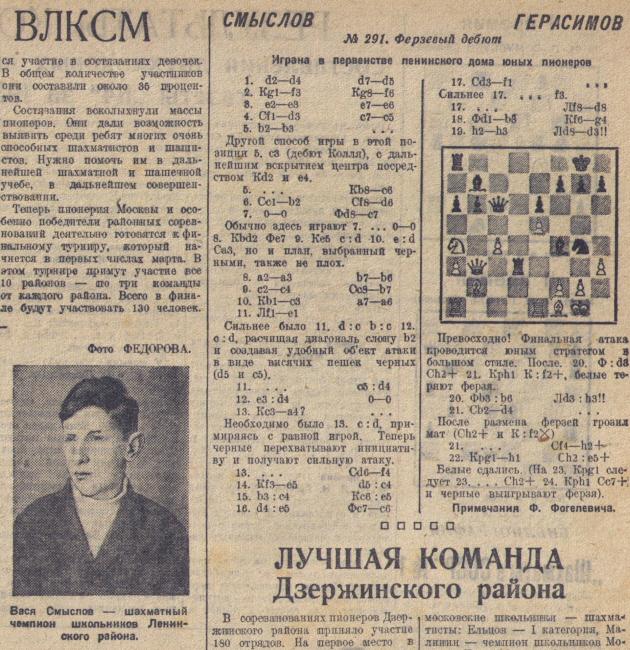
Our correspondent notes that the brilliancy, annotated by Fedor Lvovich Fogelevich (1909-1941), was presented as if Smyslov were White.
It became a famous game. See, for instance, pages 176-177 of The Chess Companion by I. Chernev (New York, 1968).
6538. Débutant in Scarborough
This article by G.H. Diggle, taken from page 4 of Chess Characters (Geneva, 1984), was first published in Newsflash, January 1975:
‘Perhaps the most exciting memory of any chessplayer is his first Tournament. The present writer’s début (or débâcle) was in the 3rd Class Section of the Scarborough Festival, 1928, where if he didn’t “conquer”, he at least “came and saw” for the first time such bygone heroes as W. Winter (1st Prize, Premier), E. Colle (2nd), R.P. Michell (3rd), Sir George Thomas, F.D. Yates, Victor Buerger, H. Saunders and Vera Menchik – the last-named at the age of 22 playing for the first time in the ranks of the masters, and confounding the “doubting ones” by beating Yates (then British Champion) in the very first round. The pair presented a strange contrast – the pleasant buxom and impassive girl and the small wiry professional, “peering and blinking” at the board, with a great heap of notes and news cuttings at his elbow (for he was handicapped by having to report the Tournament for several papers besides playing in it). Nevertheless, he had a kindly smile for his young opponent at the end of the game.
The highlight of the Congress came halfway through it when (as had been hoped) Dr Alekhine (who had just become world champion by defeating Capablanca) arrived for a three-day visit. Next evening the champion gave a simultaneous display, winning 24 and drawing one. The drawn game was the last outstanding, and the Doctor, having perambulated over three hours for his 24 victories, gratefully dropped into a chair opposite the sole survivor, who had (truth to tell) a won game with K, B, N and two pawns against Alekhine’s K and solitary rook. But what with the crowd converging all round him, the haunting fear of the Doctor’s giving up his rook for the two pawns and leaving him to win in 50 moves with K, B and N against K, and a humane reluctance to keep the world champion up all night after his arduous evening, he soon blundered away his N and agreed to a draw, receiving in return a profuse handshake from the great master.
One sadder memory. Isidor Gunsberg, then aged 74, also visited the Tournament, but his health was clearly failing, and he died two years later. In his prime it was said that “he conducted at different times more chess columns, and more at one and the same time, than any other journalist of his day”.’
Page 773 of the Skinner/Verhoeven book on Alekhine records that the world champion gave two simultaneous displays in Scarborough in 1928, conceding only one draw in each. The sole game-score available, on page 339 (a draw against C. Dawbarn), does not match the details in the above article.
6539. Steinitz and blindfold chess
The first paragraph of G.H. Diggle’s article in the preceding item, with the allusion to Veni, vidi, vici, reminds us of a feature on page 107 of the April 1885 issue of the International Chess Magazine:
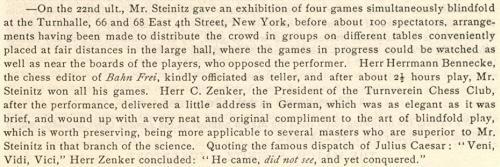
6540. Nimzowitsch’s invention (C.N.
6515)
John Blackstone (Las Vegas, NV, USA) has found a follow-up item on page 2 of the Brooklyn Daily Eagle, 19 October 1911:
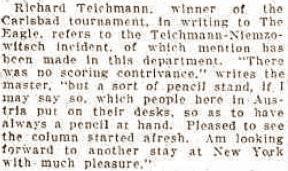

Richard Teichmann
6541. Who? (C.N. 6526)

This photograph shows a literary figure seldom mentioned nowadays: Lucie Delarue-Mardrus (1874-1945). She made a number of substantial appearances in Les Cahiers de l’Echiquier Français, beginning in issue nine (1927). Page 266 described her as ‘une éminente femme de lettres’ and referred to her interest in chess (‘J’aime en effet jouer aux échecs aussitôt que je trouve un moment dans ma vie surmenée’), although she stated that she had been playing the game for only a year. The magazine also quoted her previously-unpublished ‘Sonnet des échecs’. Page 267 had the above photograph (it also appeared opposite page 650 of the June 1927 issue of L’Echiquier), and page 268 gave a longer poem by her, ‘Ballade des échecs’, which had appeared in La Stratégie of July 1926 (page 159). The article stated that in a lengthy discussion with the Cahiers she had mentioned her wish to make a radio presentation on chess and to devote a few pages to the game in her next novel.
The tenth Cahier, also published in 1927, reproduced (on pages 301-303) an article entitled ‘L’Empire de la Dame’ which had been on page 1 of L’Intransigeant of 7 June 1927:
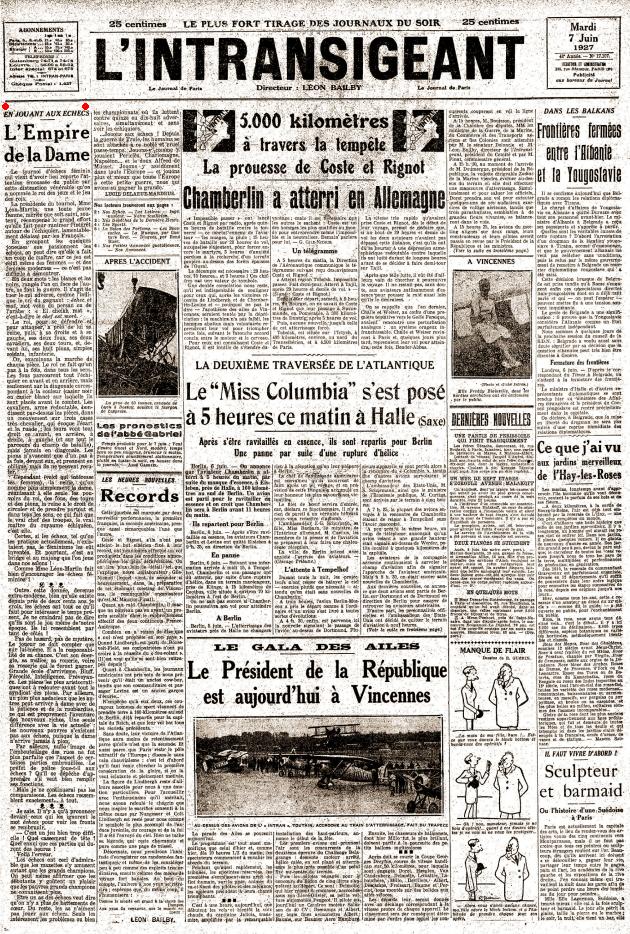
The following year, issue 14 of the Cahiers (pages 426-427) reprinted a newspaper article in which she described herself as a ‘joueuse fervente’ and encouraged women to play chess. The final paragraph:
‘Je regrette de n’être pas féministe. Je dirais à mes sœurs qui rêvent de gouverner un jour: “Continuez à jouer aux échecs comme vous y jouez, mesdames. Vous ne trouverez jamais meilleure école pour vous préparer aux combats politiques.”’
Finally, Cahier 31 (1932) had a further chess poem by her, entitled ‘Enigme’ and dated January 1932 (pages 445-446).
Dominique Thimognier (Fondettes, France) supplied the above page from L’Intransigeant, also pointing out that there exists an Association des Amis de Lucie Delarue-Mardrus. Furthermore, he draws attention to the page on the 1928 French women’s championship at his Héritage des échecs français website. A newspaper report reproduced there announced that Lucie Delarue-Mardrus would be participating in the tournament, but her name is absent from the crosstable.
6542. Who are the masters?

6543. The length of matches
In 1866 Steinitz defeated Anderssen +8 –6 =0. It is worth recalling from C.N. 3983, and not least in any discussion of the optimum length of matches, Steinitz’s comments on page 207 of the July 1888 International Chess Magazine:
‘I have frequently expressed my doubts whether I was really stronger than Anderssen (the only other player [i.e. apart from Mongrédien] with whom both Morphy and I crossed swords in a match) when I defeated him, it is true, by the small majority of two games only, and I have often thought and still think that probably the German professor who stood no chance against Morphy, could at the time have beaten me in a longer match.’
6544. A chatty injustice
Page 111 of Test Your Chess Piece Power by J.N. Walker (Oxford, 1980) intensified an old injustice by ascribing to Jean Dufresne a missed mate in one which, as shown in C.N.s 6276 and 6288, was perpetrated some 17 years after Dufresne’s death:
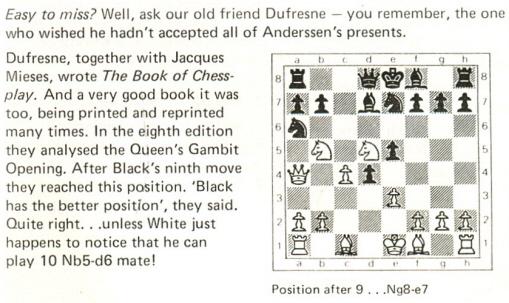

6545. Steinitz’s daughter (C.N. 3189)
C.N. 3189 (see pages 194-195 of Chess Facts and Fables) quoted Steinitz’s words on page 42 of the February 1888 International Chess Magazine, in his ‘Personal and General’ feature:
‘This is not a private column, but I beg leave to announce that my most cherished hopes are dead and buried in the grave of my daughter, an only child who, on the 13th ult., died at the age of 21 years from rheumatism of the heart after an illness of nearly four months.’
After commenting that no photograph of Steinitz’s daughter was known to us in any chess book, we asked whether a reader could find a Cuban item referred to on page 79 of the Columbia Chess Chronicle, 17 March 1888:
‘El Sport, of Havana, devotes the entire first page to a portrait of the late Flora Steinitz.’
Now, Christian Sánchez (Rosario, Argentina) points out that a text from El Sport, entitled ‘Heure de nuit’, was reproduced on pages 220-222 of En el ocaso by A.C. Vázquez (Havana, 1898). The tribute to Flora Steinitz stressed the extensive assistance which she had given her father (‘Ella era quien llevaba los libros mercantiles, la correspondencia epistolar, la dirección de todos los negocios del Sr. Steinitz’) and stated that the master always carried a portrait of her (‘retrato del que no se separa ni un solo instante’).
However, no picture was given by En el ocaso, and although the article also stated ‘Al dar hoy El Sport el retrato de la señorita Steinitz ...’ we wonder whether, in that passage, the word ‘retrato’ does indeed refer to a picture, as opposed to a verbal portrait. The same question arises from the above-quoted use by the Columbia Chess Chronicle of the similarly ambiguous English equivalent of ‘retrato’: ‘portrait’.
En el ocaso specified that the tribute to Flora Steinitz appeared in El Sport (Havana) on 1 March 1888. Can that original publication be found?
In the meantime, Christian Sánchez mentions that the complete 352-page work En el ocaso has been digitized by Google Books.
6546. Prague, 1931 Olympiad (C.N. 6529)

Knud Lysdal (Grindsted, Denmark) and Calle Erlandsson (Lund, Sweden) note that the master on the right, holding his head, is the Danish champion E. Andersen, who was playing on top board, and that on the left, wearing light-coloured shoes, is K. Ruben of Denmark. The Danish team was facing Norway, which means that Andersen and Ruben’s opponents were H.C. Christoffersen and L. Hanssen respectively.
In the back row Alekhine can be seen, in play against Ståhlberg. Also visible is the name-card of A. Gromer, who was on board two for France, against G. Stoltz.
The photograph was taken during the second round of the Olympiad, on 12 July 1931.
6547. Erik Andersen
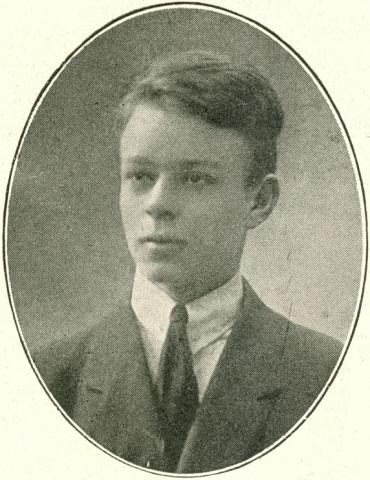
This photograph of Erik Andersen (1904-1938) is taken from page 498 of Alt om Skak by B. Nielsen (Odense, 1943). An extract from the brief obituary of Andersen by Harry Golombek on page 157 of the April 1938 BCM:
‘An attacking player of great combinative talent, he was always dangerous to the very best, as Alekhine found out at Warsaw, 1935. Personally he was a most likeable man, being the possessor of a quiet, unobtrusive humour which distinguished him from the more boisterous nature of some of his compatriots.’
The score of the Warsaw game and an account of the controversy which arose are given on pages 530-531 of the Skinner/Verhoeven book on Alekhine.
6548. Another Prague, 1931 photograph
From opposite page xvi of the Prague, 1931 tournament book:

Mrs Agnes Stevenson (née Lawson) died on 20 August 1935, as reported on pages 393-394 of the September 1935 BCM:
‘... [she] was on her way to Warsaw to help England in the ladies’ championship of the world. She had arrived at Posen on Tuesday, the 20th, by aeroplane from Berlin, and after having completed the passport formalities she was returning to the aeroplane. Thinking it was just leaving she ran for it, and unfortunately approached the front instead of the cabin. The propellers, which had just been started, hit her on the head and killed her instantaneously.’
Her widower, Rufus Henry Streatfeild Stevenson, married Vera Menchik on 19 October 1937 (BCM, November 1937, page 551).
6549. Anderssen the teacher
Fabrizio Zavatarelli (Milan, Italy) sends an extract from page 445 of Schlesische Provinzialblätter. Neue Folge. Vierter Band, edited by Th. Oelsner (Breslau, 1865), in which Adolf Anderssen’s work as a mathematics teacher was documented:
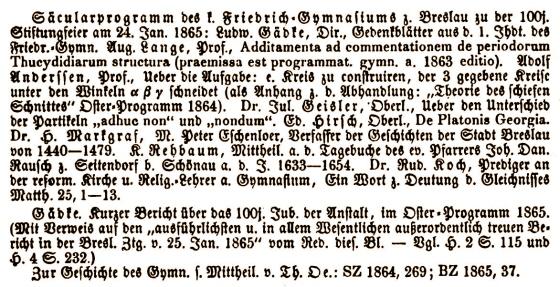
6550. Capablanca portrait
Stéphane Pilawski (Liège, Belgium) asks us to give a high-resolution copy of what he considers one of the most impressive photographs of Capablanca (the frontispiece to our monograph on the Cuban).
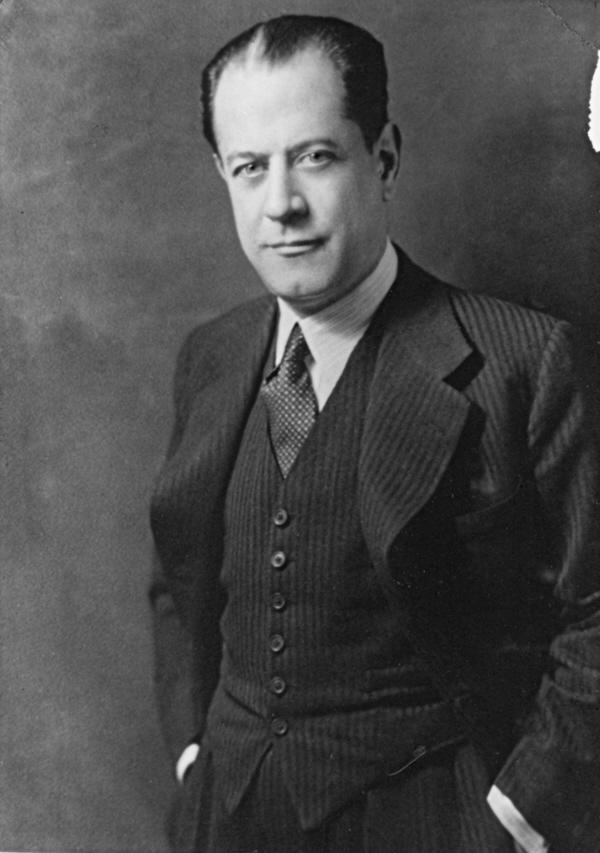
José Raúl Capablanca
6551. London war damage
‘A remarkable feature of the “Blitzkrieg” is the quite disproportionate amount of damage inflicted on concerns dealing in chess materials and books.’
That observation from page 166 of the June 1941 BCM is quoted in Chess: Hitler and Nazi Germany. We add below a comment by Norman Knight on page xi of the Preface to his compilation Chess Pieces (London, 1949):
‘My task has been made the harder by reason of an “incident” during the night of 12 [sic] May 1941, when several German incendiary bombs fell in the British Museum Library, and it so happened that of the nine million books stored there it was the chess section that suffered most severely.’
Is Knight’s assertion factual or scaccocentricity?

6552. Who are the masters? (C.N. 6542)
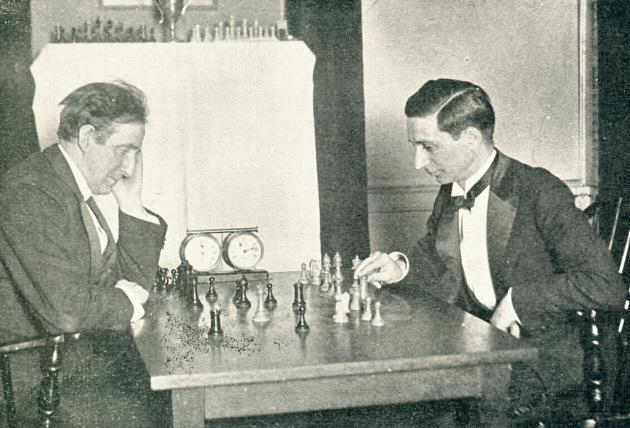
In this photograph, taken from page 8 of the December 1944 Chess Review, Frank J. Marshall and Edward Lasker are engaged in the first game of their 1923 match for the US championship. Lasker is about to play 31 Rc2, the move which was sealed at the first adjournment (American Chess Bulletin, March 1923, pages 51-52). For his notes to parts of the game, see pages 251-256 of his book Chess Secrets I Learned from the Masters (New York, 1951).
6553. Sämisch v Alekhine (C.N. 5333)
As reproduced below, C.N.
5333 discussed a position from Sämisch v Alekhine,
Prague, 15 December 1942, the matter having been raised
by Charles Sullivan (Davis, CA, USA) in connection with
page 696 of the Skinner/Verhoeven volume on Alekhine.
The continuation is given in the book as 26 Nxa7 Bg5, and Mr Sullivan asks if both players really missed 26...Ra8, which wins the knight.
Here, the source specified by Skinner and Verhoeven was page 51 of the Lachaga booklet Prag, 1942 (Martínez, 1973). We have checked the score in another book (also listed in the bibliography, on page 790): Durasův turnaj – Praha 1942 by Karel Průcha (Prague, 1943). It too had the same sequence (1 e4 e5 2 Nf3 d6 3 d4 Nd7 4 Bc4 c6 5 a4 h6 6 Nc3 Be7 7 O-O Ngf6 8 Qe2 Qc7 9 Rd1 Nf8 10 dxe5 dxe5 11 Ne1 Ne6 12 Bxe6 Bxe6 13 Nd3 O-O 14 Be3 b6 15 h3 c5 16 f4 exf4 17 Nxf4 Qe5 18 Nd3 Qh5 19 Qxh5 Nxh5 20 g4 Nf6 21 Nf4 Rad8 22 Rxd8 Rxd8 23 a5 Bc8 24 Nb5 Nxe4 25 a6 Bd7 26 Nxa7 Bg5). Before concluding that there was indeed a double blunder by Sämisch and Alekhine, we should like to know what moves were given in any other publications of the time. The game (drawn at move 41) is absent from the various Czech and German sources currently available to us.
The question has been taken up by Peter Anderberg in an article ‘Der junge Sämisch’ on pages 52-73 of the April-June 2010 issue of Kaissiber. He reports that Sämisch gave the game in the chess column of the Berliner Lokal-Anzeiger, 16 January 1943 and that after 22 Rxd8 ...
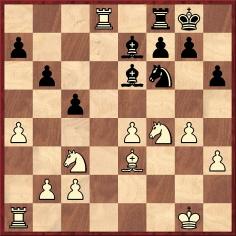
... the reply was 22...Bxd8, and not 22...Rxd8. Thus in the Berliner Lokal-Anzeiger version of the score (1 e4 e5 2 Nf3 d6 3 d4 Nd7 4 Bc4 c6 5 a4 h6 6 Nc3 Be7 7 O-O Ngf6 8 Qe2 Qc7 9 Rd1 Nf8 10 dxe5 dxe5 11 Ne1 Ne6 12 Bxe6 Bxe6 13 Nd3 O-O 14 Be3 b6 15 h3 c5 16 f4 exf4 17 Nxf4 Qe5 18 Nd3 Qh5 19 Qxh5 Nxh5 20 g4 Nf6 21 Nf4 Rad8 22 Rxd8 Bxd8 23 a5 Bc8 24 Nb5 Nxe4 25 a6 Bd7 26 Nxa7 Bg5 27 c4 Ra8 28 Nb5 Bxb5 29 cxb5 Nd6 30 Nd5 Bxe3+ 31 Nxe3 Nxb5 32 Nd5 Ra7 33 Ra4 f6 34 Nxb6 Nc7 35 Nd7 Rxa6 36 Nxc5 Rc6 37 Ra5 Rb6 38 b3 Rd6 39 Ra7 Rc6 40 Ra5 Rd6 41 Ra7 Drawn) no opportunity to win the white knight with ...Ra8 arose at move 26. The article in Kaissiber includes Sämisch’s annotations to the game (see pages 72-73).
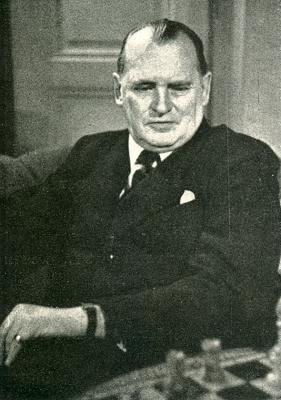
Alexander Alekhine (Prague, 1942 tournament book by Karel Průcha)
6554. Pouring the pieces
Page 166 of The Most Instructive Games of Chess Ever Played by I. Chernev (New York, 1965) gave a famous quote ascribed to Bird, regarding Steinitz:
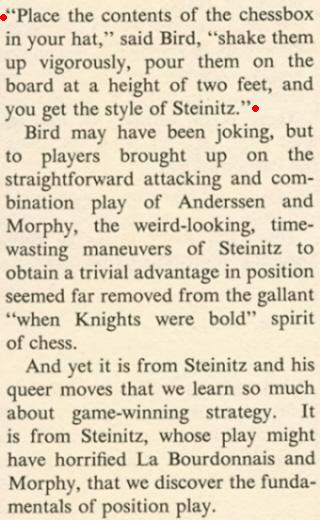
We do not recall the remark in Bird’s books, but the following appeared on page 177 of the Chess Amateur, March 1913, in an article about Steinitz by R.J. Buckley:
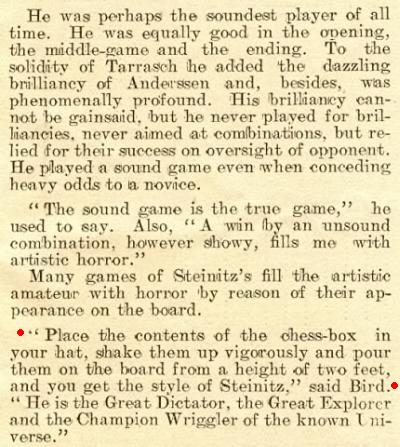
The article was reproduced on pages 132-135 of the June 1913 American Chess Bulletin.
However, in the April 1982 Newsflash (see C.N. 4554) G.H. Diggle wrote regarding W.N. Potter:
‘But his eccentric opening play fascinated Steinitz, on whose own style (Dr Lasker tells us) Potter had a great influence. “Put all the pieces into a hat”, said Steinitz, “and shake them out on to the board, and you have Potter’s style exactly.”’
This discrepancy was mentioned on page 44 of William Steinitz, Chess Champion by Kurt Landsberger (Jefferson, 1993). Can it be explained?
6555. Who?
A rather easier question than usual:
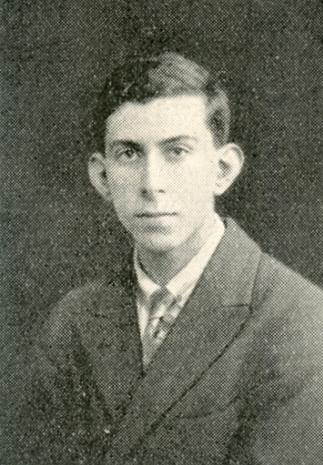
6556. Boys’ Life
Douglas McMullen (Brooklyn, NY, USA) writes:
‘Can you provide information about Fischer’s chess columns in Boys’ Life and perhaps reprint one of them?’
The subject of Boys’ Life (‘published by the Boy Scouts of America’) was first raised in C.N. 1649. The following year (1989), C.N. 1816 presented gleanings from the column, copies having been provided by Richard Reich. C.N. 1893 reverted to the topic after another correspondent, Richard Lappin, sent us a further column from Fischer’s series. We now reproduce our material (from the 1989 volume of Chess Notes) in the form of a feature article, Fischer’s Chess Column in Boys’ Life.
In addition, a complete illustrative column (June 1968, page 22) is shown:

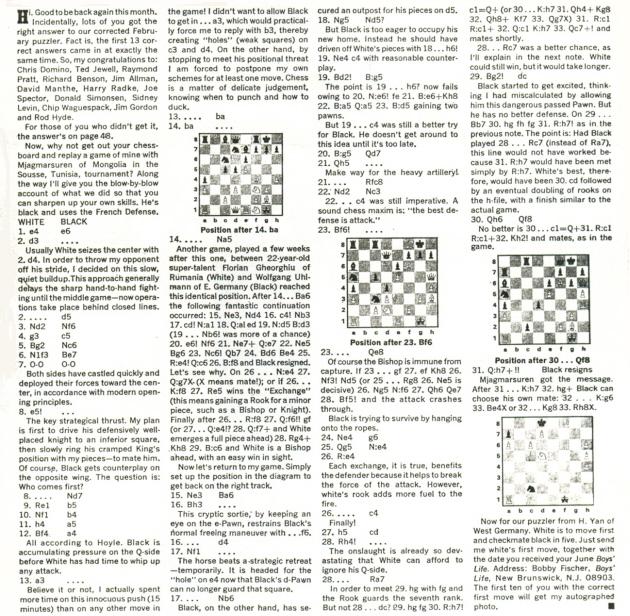
| First column | << previous | Archives [69] | next >> | Current column |
Copyright: Edward Winter. All rights reserved.

